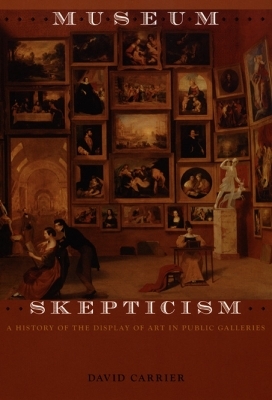
Museum Skepticism
Duke University Press (Verlag)
978-0-8223-3694-5 (ISBN)
In Museum Skepticism, art historian David Carrier traces the birth, evolution, and decline of the public art museum as an institution meant to spark democratic debate and discussion. Carrier contends that since the inception of the public art museum during the French Revolution, its development has depended on growth: on the expansion of collections, particularly to include works representing non-European cultures, and on the proliferation of art museums around the globe. Arguing that this expansionist project has peaked, he asserts that art museums must now find new ways of making high art relevant to contemporary lives. Ideas and inspiration may be found, he suggests, in mass entertainment such as popular music and movies.Carrier illuminates the public role of art museums by describing the ways they influence how art is seen: through their architecture, their collections, the narratives they offer museum visitors. He insists that an understanding of the art museum must take into account the roles of collectors, curators, and museum architects. Toward that end, he offers a series of case studies, showing how particular museums and their collections evolved. Among those who figure prominently are Baron Dominique Vivant Denon, the first director of the Louvre; Bernard Berenson, whose connoisseurship helped Isabella Stewart Gardner found her museum in Boston; Ernest Fenollosa, who assembled much of the Asian art collection now in the Museum of Fine Arts, Boston; Albert Barnes, the distinguished collector of modernist painting; and Richard Meier, architect of the J. Paul Getty Center in Los Angeles. Carrier’s learned consideration of what the art museum is and has been provides the basis for understanding the radical transformation of its public role now under way.
David Carrier is the Champney Family Professor of Art History at Case Western Reserve University and the Cleveland Institute of Art. His books include Sean Scully; Writing about Visual Art; The Aesthetics of Comics; High Art: Charles Baudelaire and the Origins of Modernist Painting; Principles of Art History Writing; and Poussin’s Paintings.
Acknowledgments ix
Overture 1
1. “Beauty and Art, History and Fame and Power”: On Entering the Louvre 17
2. Art and Power: Time Travel in the Museum 39
3. Museum Skeptics 51
4. Picturing Museum Skepticism 74
5. Art Museum Narratives 91
6. Isabella Stewart Gardner’s Museum 110
7. Ernest Fenollosa’s History of Asian Art 126
8. Albert Barnes’s Foundation and the Place of Modernist Art within the Art Museum 146
9. The Display of Absolutely Contemporary Art in the J. Paul Getty Museum 165
10. The End of the Modern Public Art Museum: A Tale of Two Cities 181
Conclusion: What the Public Art Museum Might Become 208
Notes 225
Bibliography 269
Index 305
| Zusatzinfo | 22 illustrations |
|---|---|
| Verlagsort | North Carolina |
| Sprache | englisch |
| Maße | 156 x 235 mm |
| Gewicht | 463 g |
| Themenwelt | Kunst / Musik / Theater ► Kunstgeschichte / Kunststile |
| Geisteswissenschaften ► Geschichte ► Hilfswissenschaften | |
| ISBN-10 | 0-8223-3694-4 / 0822336944 |
| ISBN-13 | 978-0-8223-3694-5 / 9780822336945 |
| Zustand | Neuware |
| Haben Sie eine Frage zum Produkt? |
aus dem Bereich


